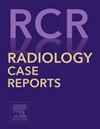罕见的松果体星形细胞瘤伴出血性改变:诊断和手术的挑战
Q4 Medicine
引用次数: 0
摘要
松果体星形细胞瘤是一种罕见的中枢神经系统肿瘤,由于其根深蒂固的位置和非特异性的临床特征,给诊断和治疗带来了挑战。本病例报告描述了一位37岁女性,她表现为感觉改变、持续性头痛和抛射性呕吐20天。初步检查显示生命体征稳定,格拉斯哥昏迷评分降低,需要立即插管。脑部核磁共振成像(MRI)显示松果体区实性囊性病变,伴脑室内延伸,中脑肿块效应及出血性改变。磁共振波谱(MRS)结果显示,胆碱和脂质峰值升高,n -乙酰天冬氨酸减少,提示肿瘤病因。患者经小脑上幕下入路行枕下开颅手术切除部分肿瘤。组织病理学分析证实该病变为IV级星形细胞瘤。术后恢复稳定,由于肿瘤的高级别性质,计划进一步进行辅助放疗和化疗。本病例强调结合临床表现、先进的影像技术和组织病理学评估来准确诊断和治疗罕见松果体区肿瘤的重要性。尽管手术干预,高级别星形细胞瘤的预后仍然很差,这强调了继续研究靶向治疗和新治疗方法的必要性。本文章由计算机程序翻译,如有差异,请以英文原文为准。
A rare case of pineal astrocytoma with hemorrhagic changes: Diagnostic and surgical challenges
Pineal astrocytoma is an uncommon central nervous system tumor, presenting diagnostic and therapeutic challenges due to its deep-seated location and nonspecific clinical features. This case report describes a 37-year-old female who presented with altered sensorium, persistent headache, and projectile vomiting for 20 days. Initial examination revealed stable vitals and a reduced Glasgow Coma Scale score, necessitating immediate intubation. Magnetic resonance imaging (MRI) of the brain revealed a solid-cystic lesion in the pineal region with intraventricular extension, mass effect on the midbrain, and hemorrhagic changes. Magnetic resonance spectroscopy (MRS) findings, including elevated choline and lipid peaks with reduced N-acetyl aspartate, suggested a neoplastic etiology. The patient underwent a suboccipital craniotomy via a supracerebellar infratentorial approach for partial tumor excision. Histopathological analysis confirmed the lesion as a grade IV astrocytoma. Postoperative recovery was stable, and further management with adjuvant radiotherapy and chemotherapy was planned due to the high-grade nature of the tumor. This case highlights the importance of integrating clinical findings, advanced imaging techniques, and histopathological evaluation to accurately diagnose and manage rare pineal region tumors. Despite surgical intervention, the prognosis for high-grade astrocytomas remains poor, underscoring the necessity for continued research into targeted therapies and novel treatment approaches.
求助全文
通过发布文献求助,成功后即可免费获取论文全文。
去求助
来源期刊

Radiology Case Reports
Medicine-Radiology, Nuclear Medicine and Imaging
CiteScore
1.10
自引率
0.00%
发文量
1074
审稿时长
30 days
期刊介绍:
The content of this journal is exclusively case reports that feature diagnostic imaging. Categories in which case reports can be placed include the musculoskeletal system, spine, central nervous system, head and neck, cardiovascular, chest, gastrointestinal, genitourinary, multisystem, pediatric, emergency, women''s imaging, oncologic, normal variants, medical devices, foreign bodies, interventional radiology, nuclear medicine, molecular imaging, ultrasonography, imaging artifacts, forensic, anthropological, and medical-legal. Articles must be well-documented and include a review of the appropriate literature.
 求助内容:
求助内容: 应助结果提醒方式:
应助结果提醒方式:


